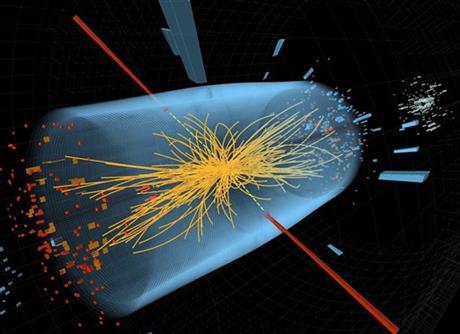
By FRANK JORDANS
FILE – This undated image made available by CERN shows a typical candidate event in the search for the Higgs boson, including two high-energy photons whose energy (depicted by red lines) is measured in the CMS electromagnetic calorimeter. The yellow lines are the measured tracks of other particles produced in the collision. Physicists Francois Englert of Belgium and Peter Higgs of Britain have won the 2013 Nobel Prize in physics, Tuesday Oct. 8, 2013. The Royal Swedish Academy of Sciences cited the two scientists for the “theoretical discovery of a mechanism that contributes to our understanding of the origin of mass of subatomic particles.” (AP Photo/CERN, File)
So what is the Higgs boson, the elusive particle that physicists Peter Higgs and Francois Englert theorized about and won the Nobel Prize for on Tuesday? The subatomic particle — which has also been called the “God particle” by some because it is seen as fundamental to the creation of the universe — has been the subject of an intense scientific hunt at the world’s biggest atom smasher near Geneva. Last year, scientists at CERN, the European Organization for Nuclear Research, announced they had finally detected the long-sought particle.
WHAT EXACTLY IS THE GOD PARTICLE?
Everything we see around us is made of atoms, inside of which are electrons, protons and neutrons. And those, in turn, are made of quarks and other subatomic particles. Scientists have wondered how these tiny building blocks of the universe acquire mass. Without mass, the particles wouldn’t hold together — and there would be no matter.
One theory proposed separately by Higgs and Englert is that a new particle must be creating a “sticky” energy field that acts as a drag on other particles. Atom-smashing experiments at CERN have since confirmed that this particle exists in a form that is similar to — but perhaps not exactly like — what was proposed.
WHY DOES THIS MATTER?
The Higgs particle is part of many theoretical equations underpinning scientists’ understanding of how the world came into being. If the particle didn’t exist, then those theories would have needed to be fundamentally overhauled. The fact that it does exist gives more weight to the so-called Standard Model of particle physics, which explains how much of the universe works at the subatomic level. Scientists say there is still work to be done, especially because neutrinos — subatomic particles that were previously thought to be without mass — do now appear to have mass. Researchers are also still trying to figure out how to account for so-called dark matter, the over four-fifths of matter in the universe that can’t be seen.
HOW MUCH DID THE HUNT FOR THE HIGGS COST?
CERN’s atom smasher, the Large Hadron Collider, is a 17-mile (27-kilometer) tunnel beneath the Swiss-French border that cost some $10 billion to build and run. This includes the salaries of thousands of scientists and support staff around the world who have collaborated on the two experiments that independently pursued the Higgs particle.
WHY SPEND SO MUCH MONEY CONFIRMING A SCIENTIFIC THEORY?
While there haven’t been any practical applications from discovering the Higgs boson, the massive scientific effort that led up to its discovery has already paid off in other ways. Researchers at CERN helped develop the World Wide Web to store and exchange ideas over the Internet. The vast computing power needed to crunch all of the data produced by the atom smasher has also boosted the development of cloud computing, which has found its way into the mainstream as sophisticated web applications. Advances in solar energy capture, medical imaging and proton therapy to fight cancer have also resulted from the work of particle physicists at CERN and elsewhere.



